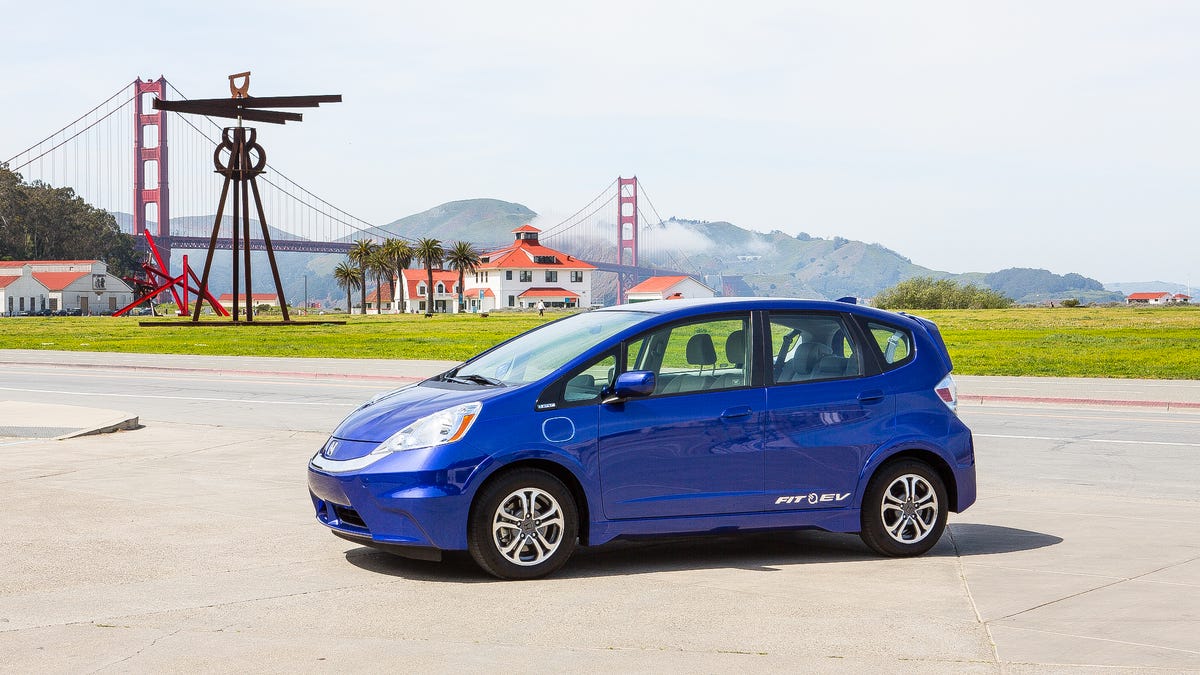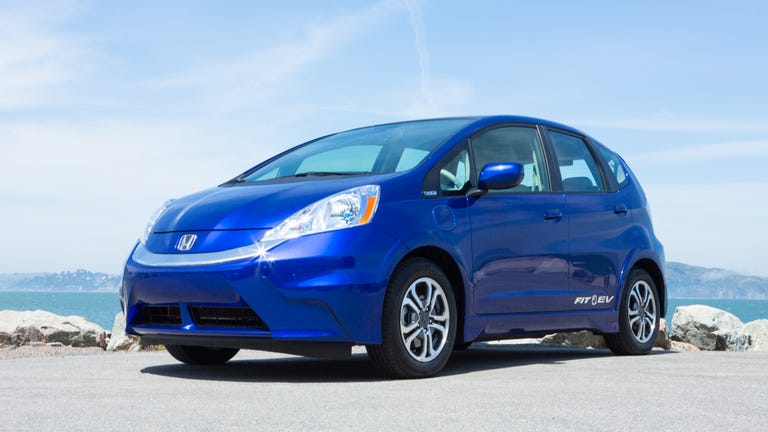 Why You Can Trust CNET
Why You Can Trust CNET 2013 Honda Fit EV review: Honda Fit EV's cabin tech belies efficient, electric drivetrain
Its drivetrain may be cutting-edge, but the cabin electronics, metal ignition key, and handbrake make the Honda Fit EV look old.
While out testing the 2013 Honda Fit EV, I wanted to run its range down from a full charge to under 10 miles. My problem: the trip computer showed 14 miles left and I was in the middle of San Francisco. It might take me half an hour to get to the CNET garage, but I would only cover about 3 miles getting there. That's city driving for you.
The Good
The Bad
The Bottom Line
So I cheated by hitting the Sport button, which not only brought up red accent lighting on the instrument panel but also recalculated the remaining range, bringing it down to 9 miles.
As with most electric cars currently on the market, the Fit EV gets less than 100 miles range on a full charge, 82 miles as estimated by the EPA. In my experience, the car's trip computer showed anywhere from 90 to 100 miles' range on a full charge and in Eco mode.
For my journey mentioned above, I covered 67.4 miles and rolled into the garage with 10 miles left in Eco mode, making for a total of 77.4 miles. However, I had spent 46.8 miles of that trip traveling at 65 mph on the freeway, a particularly energy-intensive exercise for the barely aerodynamic Fit EV. On surface streets, I had mostly kept it in Eco mode, going to Normal for the freeway.
More than a few people could complete a daily commute with the kind of range I got from the Fit EV and have substantial miles left over.
During my time with the Fit EV, I became familiar with something electric-car owners enjoy: starting each day with a fully charged battery. That fact made me realize the inconvenience of how gasoline-fueled cars make you plan a special trip or detour to a gas station. Some decades from now, people will consider trips to the gas station quaint, somewhat like having the ice man come by to fill up the icebox would seem today.

I also got to experience electric-car owner smugness as I sat in traffic and noticed the rippling effect of the exhaust and heat being emitted by all the other cars around me. I enjoyed the fact that my own little ride was running much cooler, spitting zero CO2 or pollutants into the surrounding air, and getting the equivalent of 118 mpg, according to EPA mileage figures. Environmental superiority for the win.
Retrofit
As you can guess by its name, the Fit EV is a relative of Honda's gasoline-powered Fit model . When automakers build electric cars, they can either retrofit an existing model or design something new from the ground up. The former tends to be cheaper, but the latter strategy results in a better overall car. Witness the Tesla Model S , the Nissan Leaf , and the BMW i3 .
Honda went the former route with its Fit EV, but managed some pretty serious engineering changes to compensate for the problems of a retrofit. Jamming batteries into any available space can lead to poor weight balance, so Honda lifted the Fit EV's body slightly, making space for the battery pack under the floorboards, evening out the weight distribution, and lowering the center of gravity.
To accommodate the approximately 750-pound weight gain of the Fit EV over the standard Fit, Honda swapped the rear torsion bar suspension for a more advanced multilink system. That change undoubtedly helps the car's handling, but does not wholly defeat the oddly heavy ride feel.
Beyond eliminating the tailpipe, Honda made a few other changes to the Fit's exterior. A wide, chrome smile replaces the front grille, as the electric motor and battery cooling system does not need a big air intake. The fuel filler goes away, replaced by a J1772 charging port up the left-front fender.
The interior feels as roomy as the standard Fit, but gone is the versatile Magic Seat that opened up so much cargo space. The Fit EV comes with a simple rear fold-down seat, necessitated by the structural changes. Honda notes that the seat coverings consist of bio-fabric polyethylene terephthalate and feel as funky as that name sounds. However, this material comes from renewable sugar cane, so another point for environmental superiority.
Instead of traditional instruments, the Fit EV gets analog power-usage and charge-level gauges. Dominating the center of the instrument panel, an LCD shows the car's current speed in digital format, plus a driver-configurable screen for trip data, with the all-important remaining range.
Going against the high-tech grain, a lever-style handbrake adorns the console, and a metal key starts the car.
Modes
The Fit EV's drive modes, Eco, Normal, and Sport, not only affected what the trip computer showed, but drastically changed the driving character. In Eco, signified by green accents on the instrument cluster, the car responded mushily to the accelerator. When I hit the Normal button, the accelerator released the 189 pound-feet of torque from the 92-kilowatt drive motor more readily. Sport mode unleashed the motor's full capability, twisting the front wheels aggressively with my least touch of the accelerator pedal.
In my driving, I found the Fit EV's Eco mode perfectly suitable for cities and suburbs but completely inadequate for the freeway. The mushy accelerator response was generally not a negative, though, as it led to smooth take-offs. In Sport and Normal, the Fit EV tended to lurch with all that instant-on torque.
Setting the Fit EV pointing up a steep San Francisco hill, I hit the accelerator and was pleased to feel the car move readily, even in Eco mode, gradually but inexorably picking up speed.
Honda tuned a fair amount of play in the electric power-steering system, such that I could move the wheel a bit with no response from the car. That steering tuning didn't change when I hit the Sport button, as that mode only affects power delivery.
Along with a slight whir of the drive motor as I accelerated over city streets, the Fit EV could not disguise its weight. Where I'm used to small cars feeling light and nimble, the extra weight from the batteries was obvious. The suspension, while well-tuned to handle the weight, gave the compact Fit EV a truck-like ride.
However, the low-slung weight of the car enhanced its stability, especially when I slung it around a cloverleaf freeway on-ramp. Less help were the small, 15-inch wheels.
Electronics
Like the hand-lever emergency brake, the navigation head unit, included as standard, doesn't hold up the high-tech image of the Fit EV. The navigation system provides decent route guidance, and includes a live traffic feed, but the graphics are ugly and voice command for address entry was the most tedious I have ever used.
Not only did I have to enter each part of a street address separately, the system required me to hit the voice-command button at each step. When I tried entering a business name with voice command for the points-of-interest database, the system asked me to spell out each letter.
For the Fit EV, Honda added a screen to the navigation system showing the car's real-time range overlaid on a map. However, as that graphic uses straight-line range rather than actual road miles, it should only be considered as a very optimistic reference.
More useful are the car's telematics. Owners can load a special electric-car version of the HondaLink app to an iPhone or Android phone, and remotely control charging and preconditioning. Likewise, Honda included a key fob, a simple device that, when in RF proximity to the car, let me see the charge level and remotely turn on the air conditioning. That last feature is useful to precondition the car's interior temperature while it is still plugged in, drawing power from the grid instead of its batteries.
The Fit EV's touch screen controls the stereo and phone systems as well as navigation. The stereo was a little skimpy on audio sources, but it covered the important ones, with both Bluetooth and a USB port. Using the system with my iPhone, I found it was occasionally fussy about playing back music, stopping after one song over Bluetooth streaming, as one example. The USB port looks like a bit of a hack, with a simple pigtail hanging in the upper glove compartment. This detail was not very indicative of a cutting-edge tech car.
The audio system, with six speakers, is pretty average. Lacking center channel or subwoofer, this system reproduced music with a flat, mostly adequate sound.
Generations
High points about the Honda Fit EV include the drive modes, which play a big part in the car's performance, the battery pack placement, and the EPA mpg equivalent rating. That latter, at 118 mpge, denotes one of the most efficient cars available. As for the modes, Eco and Sport are as different as night and day.
However, the Fit EV is based on the second-generation Fit, currently at the end of its product cycle and not as refined or modern as the third generation, which will come out as a 2015 model. Honda has not said whether it will make an electric version of the new Fit. As Honda retrofitted the older Fit, it gets stuck with older cabin electronics that don't quite live up to its high-tech drivetrain.
Compared to dedicated electric cars such as the Nissan Leaf or BMW i3, the Honda Fit EV does not seem fully realized. It would have been more interesting if Honda had based a fully electric car on its fuel cell-powered Clarity, a car designed for an electric drivetrain.
Rather than sell the Fit EV, Honda is only offering it for lease, at a rate of $259 per month for a three-year term. That price includes unlimited mileage and insurance, making it a pretty good deal. Honda only plans to lease 1,100 of the cars, and those only in California, Oregon, New York, New Jersey, Connecticut, Massachusetts, Maryland, and Rhode Island.
Wayne's comparable picks
| Tech specs | |
| Model | 2013 Honda Fit EV |
| Powertrain | 20kWh lithium ion battery pack, 92-kilowatt electric motor, single-speed reduction gearbox |
| EPA fuel economy | 132 mpge city/105 mpge highway |
| Navigation | Standard, with live traffic |
| Bluetooth phone support | Standard |
| Digital audio sources | Bluetooth streaming, iOS integration, USB drive |
| Audio system | Six-speaker system |
| Driver aids | Backup camera |
| Base price | $37,415 |
| Price as tested | $37,415 |


